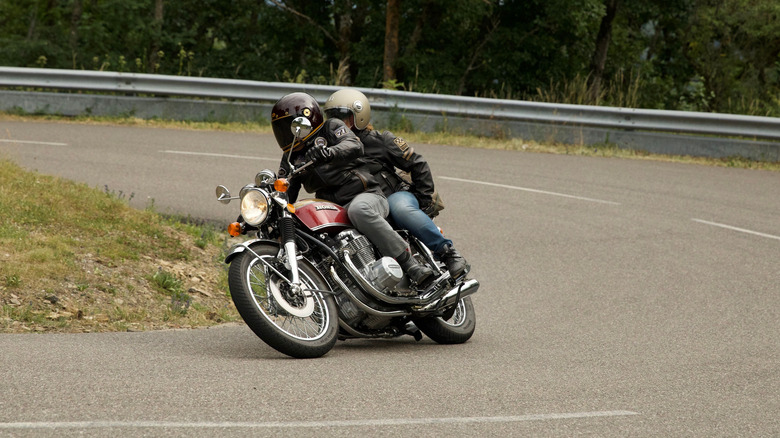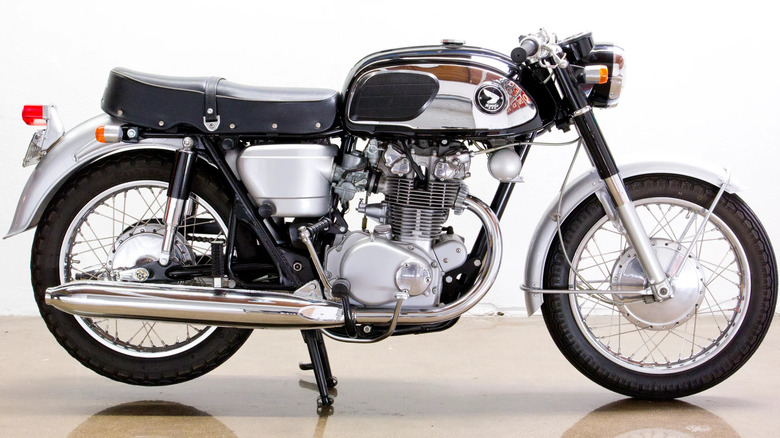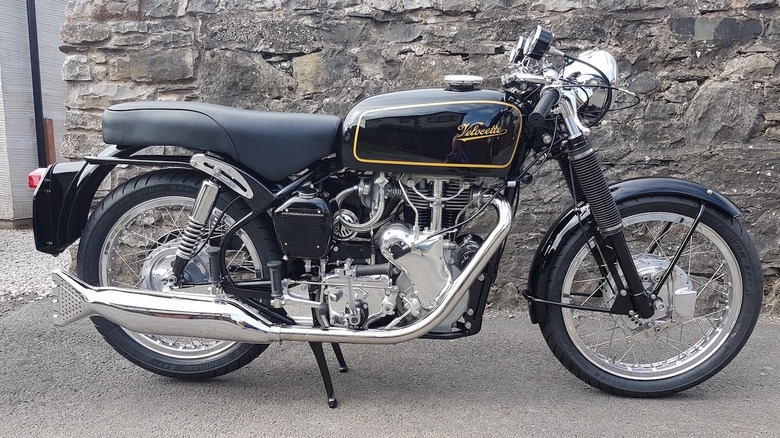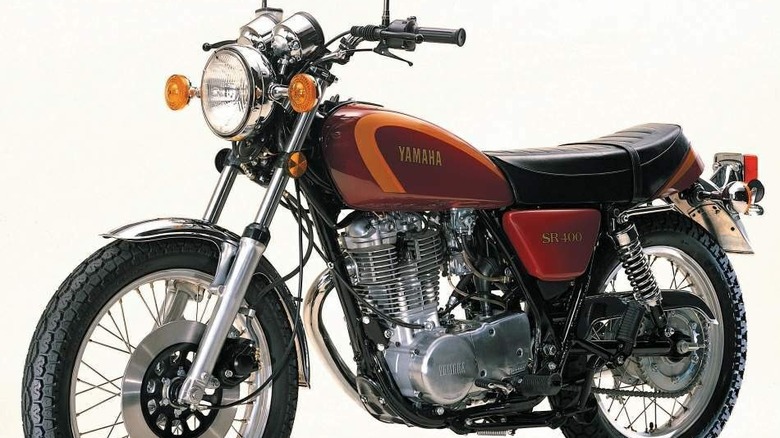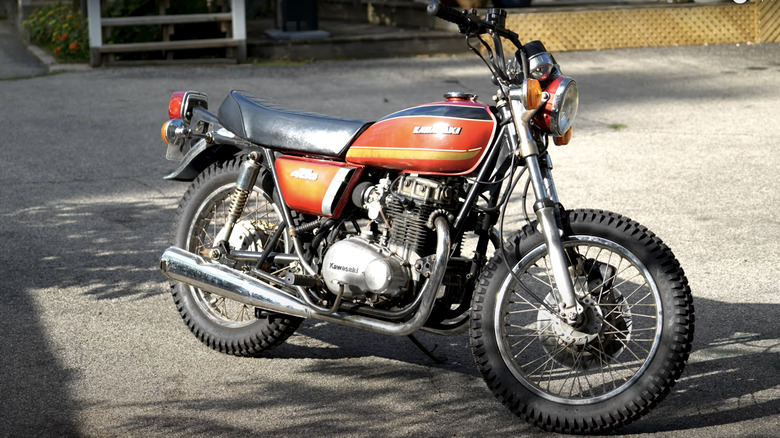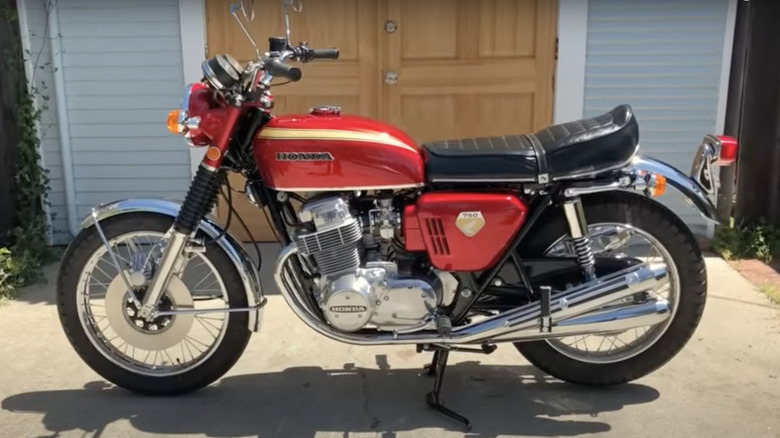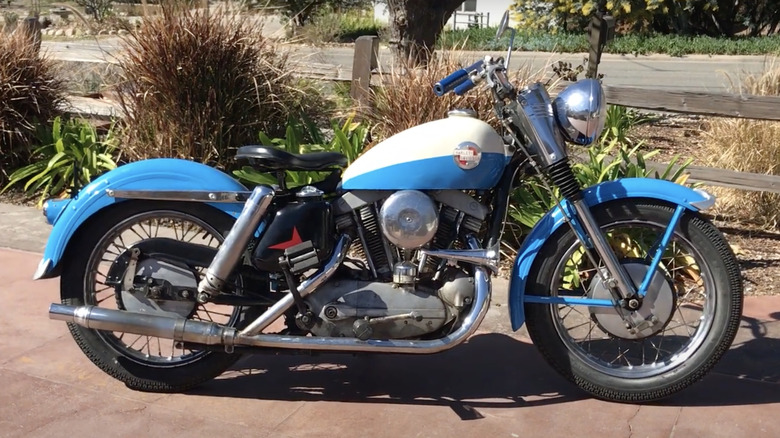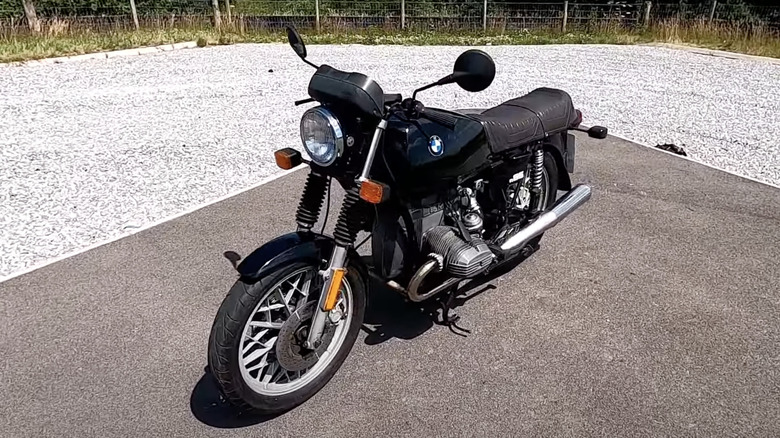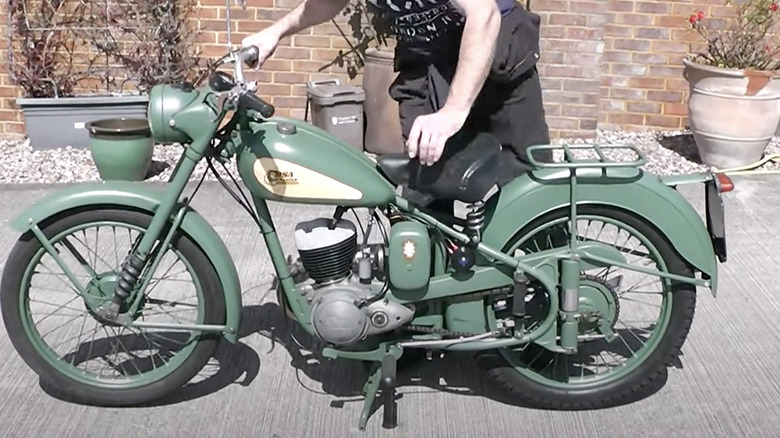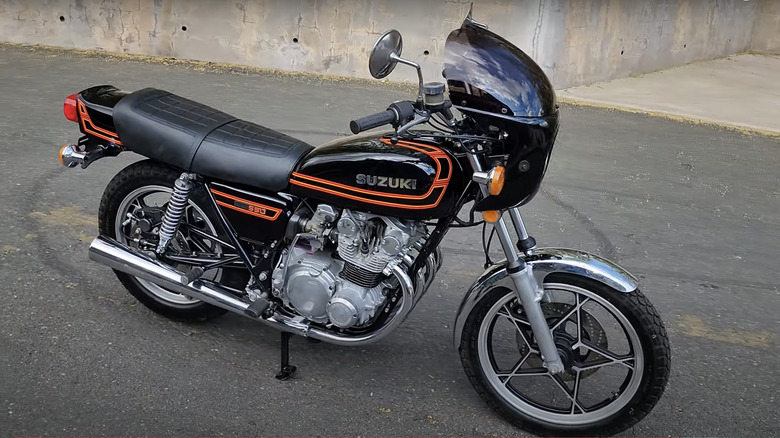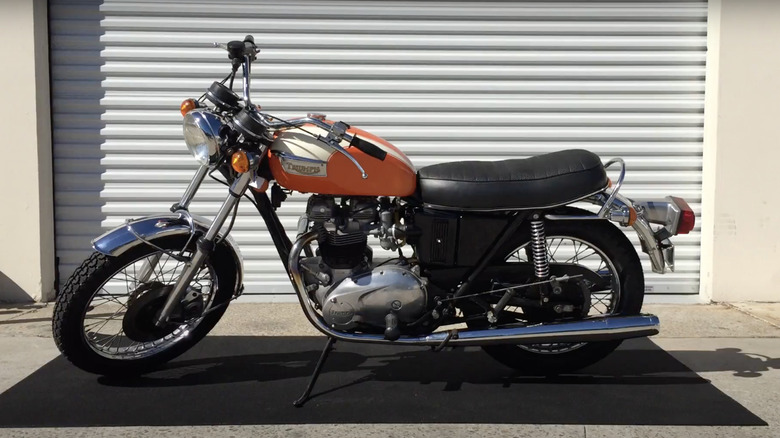10 Of The Coolest Vintage Motorcycles That Won't Break The Bank
We have seen a resurgence in classically styled motorcycles in recent years, with marques like Royal Enfield and BSA leading the charge with affordable thumpers that evoke the charm of yesteryear while sporting some modern features. These might include electronic fuel injection, upgraded suspensions, and updated brakes. Of course, there are also the likes of the continually-reissued Triumph Bonneville, Moto Guzzi V7, and Harley-Davidson Sportsters that never went away. Additionally, we have seen some contemporary iterations of discontinued motorcycles appearing seemingly out of nowhere, such as the new Norton Commando 961 and the breathtaking Brough Superior SS100.
All this indicates a market that craves the polished chrome and aesthetic appeal of vintage machines. However, for those willing to dedicate a little extra time and money to maintenance, many original vintage bikes are readily available at much lower prices than their modern counterparts. If we go with the definition of "vintage" as being anything over 35 years old, some of these machines are even appointed with relatively modern features such as electronic fuel injection, liquid cooling, and, in some cases, anti-lock brakes.
If properly looked after or well-restored, a classic motorcycle can be a rewarding acquisition. While it may require more care than a newer model, this can provide you with a fun hobby, and there is usually an accompanying "cool factor" associated with older machines that all motorcycle enthusiasts either secretly or unashamedly covet. The following are 10 undeniably cool vintage motorcycles that shouldn't break the bank.
1965 Honda CB450
The town of Brighton on England's south coast has long been a draw for motorcyclists who enjoyed its holiday atmosphere that was a short hop from London. It was a prominent destination for the Cafe Racers of the 1960s, who would congregate in the capital's coffee shops and race to the seaside on a weekend. It was also the site of the Brighton Jubilee Speed Trials of 1965, an international biking event where the Honda CB450 first appeared on the world stage.
In a demonstration sprint, the "Black Bomber," as it came to be known, achieved a top speed of 100 miles per hour and covered the one-kilometer trial distance in just over 30 seconds. While pedestrian by today's standards, this was a notable performance at the time, and a host of modern features also caught the biking public's eye. These included an electric starter, a torsion bar suspension, and a horizontal twin-cylinder configuration, unlike the British vertical twins featured on Norton and Triumph bikes.
Honda aimed to market the "Black Bomber" to the flourishing U.S. market of baby boomers who favored practicality over showboating. It had a relatively short run of just three years. It was moderately successful stateside, where a comprehensive marketing campaign helped boost Honda products and positively affected all motorcycle sales. After a revision of American market trends, the Honda CB450 was discontinued. But there is currently a lot of enthusiasm for classic Japanese bikes in the U.S. and elsewhere. If you were to buy an original CB450 today, you could expect to pay between $3,500 and $6,000 for this classic example of quality engineering that will never go out of style.
1959 Velocette Venom
A few names come to mind when we think of classic British cafe racers. These include the Norton Manx, Royal Enfield Continental GT, or the Triumph Thruxton. One model that often flies under the radar is the Velocette Venom. Yet, it harks back to 1956 and was one of the original models that would be given the racing seat and clip-on handlebars that characterized the road racers of the 1960s.
The Venom was a beefed-up 499cc cousin to the 350cc Viper and boasted a rear swing-arm and telescopic forks, features that we take for granted today but were considered game-changers at the time. By the 1960s, further improvements had been made to its brakes, and it was given a higher compression ratio and a racing gearbox, as well as optional faring on some models for added streamlining. It represented the glory days of the air-cooled, single-piston thumpers that the U.K. was renowned for, and it enjoyed a lengthy production run of 25 years.
The Velocette Venom is a true classic motorcycle and will undoubtedly require extra maintenance to keep roadworthy and due care while riding. A model in fair condition can cost as little as $6,000, with project bikes needing work costing much less. However, no matter the vintage, every Venom remains a real head-turner and can attract much higher prices at auction when well-restored.
1978 Yamaha SR400
The Yahama "SR" range consisted of small to mid-sized practical bikes with basic features. In their day, they were affordable and reliable, and the range has since been regularly reissued with several engine capacities, including 125cc, 250cc, 400cc, and 500cc variations. Of these, only the SR400 is still being produced today. All generations are much loved in the motorcycling community as accessible bikes with a standard upright riding position, tame power output, and decent handling. This makes them ideal for novice riders and city slickers looking for a nippy commuter vehicle.
The Yamaha SR400 is a single-cylinder, kick-started bike introduced in 1978 and had an impressive 24-year run before being revamped in 2002 with no significant improvements over its predecessor. It perfectly embodies the phrase "If it ain't broke, don't fix it," as it was apparent that the Japanese company got everything right from the get-go. Even the latest iteration, the 2021 model, features the same 399cc engine as the original (albeit with electronic fuel injection), a front 298-millimeter disc brake and rear drum brake combination, and a similar, timeless aesthetic.
The Yahama SR400 isn't going to turn many heads aside from those in the know, but that is part of its appeal. This classic workhorse machine will comfortably get you from A to B without a hitch, time and time again. While a brand-new model will set you back around $6,000, you can pick up an original in good condition for a third of that price.
1974 Kawasaki KZ400
Predating the Yamaha SR400 by four years was the Kawasaki Z400, and it couldn't have come at a better time. In 1974, America was reeling in the wake of global economic issues, the devaluation of the dollar following the transition off the gold standard, and a considerable hike in the cost of fuel. This meant that America had less money to spend on imported goods and transportation. Kawasaki's answer was to build a plant in Nebraska, cutting out the middleman, and by 1975, the KZ400 was flying off the production line stateside.
Unlike the SR400, the KZ400 had an electric start and a twin-cylinder, 398cc engine that was nippy and torquey enough to easily pull two people on long-haul trips. The dashboard was simple, limited to the usual tachometer, speedometer, and signal/notification lamps. The bike was resplendent in chrome, with shiny shocks, grab rail, exhaust, dials, and fenders, giving it a premium feel that belied its affordable price tag. Even the gas tank had a slick paint job that added to its retro appeal half a century later.
The KZ400 is a lightweight, easy-to-handle, classic motorcycle that is affordable when in good condition. While the first early 1970s models were available for the bargain price of $1,174, the same model will set you back around $2,500 in good condition today. Given the reliability of Japanese bikes of this era, it will likely serve you well for many years to come.
1969 Honda CB750
By 1966, Honda had five World GP titles under its belt and decided to put racing on hiatus and turn its attention to its line of consumer motorcycles. As it does with its race replica "RR" models of today, it wanted to transfer the high-performance technology it developed at the racetrack to its roadgoing bikes. At this time, Honda U.S.A. demanded a more impressive product line to boost floundering sales figures. As these two worlds collided, the result was formidable and unprecedented.
Often called the world's first superbike, the Honda CB750 had four cylinders, four carburetors, four mufflers, and a 736.5cc engine capacity, producing 67 horsepower. While this may sound pedestrian by today's standards, this was a remarkable achievement at the end of the Swinging Sixties. It had an electric starter, which was revelatory at the time, and disc brakes providing much-needed stopping power. Previously, Honda's consumer bikes had been smaller capacity, practical vehicles that catered to the modern commuter (its little Super Cub was already wildly successful). With the CB750, it adopted a "go big or go home" mentality, defying its competitors and raising the bar for high-performance consumer machines worldwide.
The original 1969 "Sandcast" CB750 (with sand-molded crankcases) is considered one of the most influential motorcycles in history, and these can cost as much as $30,000 in good condition. However, you can find much cheaper models from the mid-1970s with die-cast crankcases. These can be found for less than $9,000, but they rocket in value when in excellent shape, which is understandable, considering this motorcycle's remarkable heritage and desirability.
1957 Harley Davidson XL Series Sportster
In the mid-1950s, the great British Marques, including Norton and Triumph, were giving their American rivals a headache with their mid-capacity, nippy motorcycles that were starting to dominate the U.S. market. In 1957, Harley-Davidson reacted to these Anglo upstarts by introducing the Sportster (which is among the best motorcycles it ever made). In typical Harley style, this was bigger and more powerful than its imported counterparts. It was a sleek and sporty ride that would appeal to those who weren't fans of the bulkier "hogs" with which it was associated.
The original Harley Davidson XL Series Sportster was the start of a long tradition of Sportster motorcycles. That's still in full swing today with models like the Sportster S, which shares many features with its almost 70-year-old ancestor. These include a V-twin engine configuration, single saddle, low seat height, and forward riding position. It also still sports the "peanut" fuel tank that first appeared in the XL series. The older variety of Sportsters still have many traditional features to offer, including a kick starter, drum brakes, and a right-hand-side shifter, for added inconvenience, risk, and confusion. Still, to classic bike enthusiasts, this is all part of the experience.
If you're not fussed about it being 100% original, you can pick up a 1960s-era "Sporty" in good condition for under $9,000, and these fun, attractive bikes hold their value very well. With that said, if you have the available funds, you can find an original 1957 vintage XL Sportster in similar condition for around double that, and these are sure to appreciate over time.
1978 BMW R65
Thirty years after Harley-Davidson debuted its XL Sportster, BMW was also looking to downsize its typically large models and create a nimbler, versatile machine that would be widely accessible to the biking public. It eschewed the current trends in the late 1970s for bulkier engines, as seen on the four-cylinder Honda CB750 and Kawasaki KZ650. Instead, it stuck to the tried and true Boxer Twin two-cylinder configuration that has featured on most of its bikes before and since. Thus, 1978 heralded the arrival of the BMW R65, and it was remarkable.
In this day and age of automated precision engineering, it's easy to forget how much effort was put into creating high-end classic motorcycles to ensure they performed their best. The BMW R65 was one such machine that was impeccably crafted with great attention to detail, especially among its castings, welding, and lightweight components. It was designed with weight in mind from the ground up, evident in its performance and handling. And while it may be seen as sluggish compared to the mid-sized BMWs of today, its 648cc engine was perfectly capable of long-haul touring duties.
With the R65, BMW found success in the mid-size motorcycle market, a segment under-represented in its current product line. Older models can be reasonably priced, with an older version in good condition costing around the $4,000 mark, and they're known for their reliability and are effortlessly cool more than 40 years on.
1960s BSA Bantam
In the mid-20th century, BSA was as famous a brand as other British marques, Triumph, Norton, and Royal Enfield. Like Enfield, BSA — or "Birmingham Small Arms" — started in the 19th century making guns before transitioning to motorcycles. Like the people of this West Midlands city (as anyone who has seen "Peaky Blinders" will attest), they were hardy and practical machines, although, by the late 1970s, the company had floundered and soon closed down production for good. Or so we thought.
The BSA Bantam is a 123cc, single-cylinder British bike based on a German design. The British were quick to modify it by putting the gear shifter on the right and rebadged it to ensure it was distinguishable from its foreign counterparts, but the design was used elsewhere across Europe and the U.S. This three-speed, small-capacity bike was an endearing little runaround but wasn't without its issues. It had a weak side stand, a gear shifter that was inclined to break, and its British rewiring left much to be desired.
Despite its shortcomings, the Bantam is a cool vintage model that will look good in any garage. Many a motorcycle collector would consider buying one if only as a talking point. And after an almost 50-year hiatus, the company has been re-established in India, which has generated interest in the older BSAs such as this. You can pick up a Bantam in good condition for $2,000 to $3,000, making these a good investment opportunity.
1977 Suzuki GS550
In the mid-1970s, Suzuki was expanding its operations across the globe, with factories opening in Pakistan and Indonesia and a new motorcycle plant in Aichi, Japan. In 1976, it launched the GS series of motorcycles, which was still in production well into the 21st century, with models like the GS500F and GS150. But it's the original line of late '70s GS bikes, the 400, 550, and 750 models, that are most sought after by vintage bike collectors.
The Suzuki GS550 is like the middle sibling of the Honda CB750 and Kawasaki KZ400, as it sits between the two models regarding engine capacity and is stylistically similar to both. Most notable for a mid-sized bike such as this is its four-cylinder engine configuration, producing 49 horsepower. This was tamed with a front disc and rear drum brake configuration and managed by a six-speed gearbox, being the first in its class to have one. Typically for a Japanese motorcycle, the Suzuki GS550 was highly reliable, and it performed well and was quick enough, with a top speed of 109 miles per hour.
If you are looking for a regular steed instead of a museum piece, you could do much worse than any of the Japanese bikes listed here. They go the distance, parts are often more readily available, and each has the essential cool factor. Of these, the Suzuki is the most affordable, at around $2,000, in good condition.
1973 Triumph Bonneville T140
Anyone with a passing interest in classic motorcycles has heard of the Triumph Bonneville. It is one of the longest-serving premium classic bikes still in production today — among the best bikes made by Triumph — and like a vintage Beaujolais, it improves with each successive generation while remaining true to its roots. The U.K.-based Triumph company has had its difficulties in the past, and at the start of the 1970s, it was struggling to compete with Japanese bikes that were making impressive breakthroughs at the time. Facing possible ruin, Triumph upgraded its flagship Bonneville model from the much-loved 650cc T120 to the faster, more powerful 750cc T140 to recoup some market share.
The T140 was built to satisfy the all-important American market, especially given the past successes of the other 750cc import, the Honda CB750. It had a five-speed transmission as standard, with a sensible left-hand-side shifter, front and rear disc brakes — albeit puny ones with 254-millimeter diameters and single calipers — and a punchy parallel-twin engine, bored out from the previous generation's to achieve an extra 50cc per cylinder. The 750cc Bonneville enjoyed a lengthy 15-year run until 1988, when, after a recession caused a slump in U.S. sales and being trounced by the dominant Japanese market, the Triumph company all but collapsed.
The Triumph Bonneville is an iconic British classic, and as such, it can be expensive. While some later versions command premium prices, you can still find an affordable vintage T140 in fair condition. For as little as $4,000, you could find yourself with a well-looked-after vintage motorcycle that should hold its value and look timelessly cool as long as you own it.
